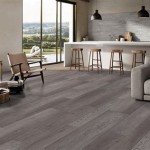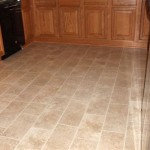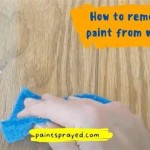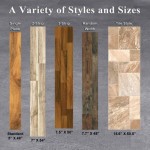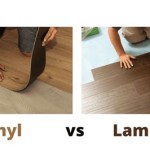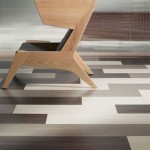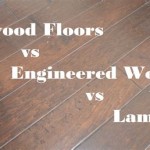Is Luxury Vinyl Flooring Safe: Addressing Common Concerns
Luxury Vinyl Flooring (LVF) has surged in popularity as a durable, aesthetically versatile, and often cost-effective alternative to traditional flooring options like hardwood, tile, and stone. Its layered construction, typically comprising a backing layer, a core layer, a print layer, and a wear layer, allows for realistic replications of various natural materials. However, alongside its benefits, concerns about the safety of LVF have arisen, primarily concerning potential chemical emissions and their impact on indoor air quality. Understanding the composition, manufacturing processes, and certifications related to LVF is crucial to evaluating its safety profile.
The safety of any flooring material hinges on the types of substances used in its production and the potential for these substances to off-gas into the surrounding environment. Off-gassing refers to the release of volatile organic compounds (VOCs) from materials into the air. VOCs are organic chemicals that have a high vapor pressure at ordinary room temperature. Some VOCs are known to have adverse health effects, ranging from minor irritations to more serious health concerns with prolonged exposure.
The primary concerns related to LVF safety revolve around the presence and release of phthalates, formaldehyde, and other VOCs. Phthalates are plasticizers often used to enhance the flexibility and durability of vinyl. Formaldehyde, a known human carcinogen, can be present in adhesives or as a byproduct of the manufacturing process. The level of these chemicals and the rate at which they are released into the air are key factors determining the safety of LVF products.
Understanding VOC Emissions and Indoor Air Quality
Volatile Organic Compounds (VOCs) are emitted as gases from certain solids or liquids. VOCs include a variety of chemicals, some of which may have short- and long-term adverse health effects. Concentrations of many VOCs are consistently higher indoors (up to ten times higher) than outdoors. VOCs are emitted by a wide array of products numbering in the thousands. Examples include paints and lacquers, paint strippers, cleaning supplies, pesticides, building materials and furnishings, office equipment such as copiers and printers, correction fluids and carbonless copy paper, graphics and craft materials including glues and adhesives, permanent markers, and photographic solutions. The potential for these chemicals to off-gas from flooring materials like LVF raises concerns about indoor air quality, particularly in enclosed spaces with limited ventilation.
The impact of VOCs on human health depends on several factors, including the type of VOC, the concentration, and the duration of exposure. Short-term exposure to high levels of VOCs can cause eye, nose, and throat irritation, headaches, nausea, and dizziness. Long-term exposure can lead to more severe health problems, including respiratory issues, organ damage, and an increased risk of cancer. Sensitive individuals, such as children, pregnant women, and people with pre-existing respiratory conditions, may be more susceptible to the adverse effects of VOCs.
To mitigate potential risks, it's crucial to select LVF products with low VOC emissions. Look for certifications from reputable organizations that test and verify VOC emissions. Common certifications include FloorScore, GREENGUARD Gold, and DIBt (Deutsches Institut für Bautechnik). These certifications indicate that the product has been tested for a range of VOCs and meets specific emission standards.
Proper ventilation is also essential for maintaining good indoor air quality. After installing new LVF, ensure adequate ventilation by opening windows and doors to allow VOCs to dissipate. Regular ventilation can help reduce the concentration of VOCs in the air and minimize potential health risks. Consider using air purifiers with activated carbon filters, which can help remove VOCs from the air.
The manufacturing process of LVF can significantly affect its VOC emissions. Some manufacturers employ techniques to reduce VOC content, such as using water-based adhesives and opting for low-VOC raw materials. Understanding the manufacturing processes and the materials used in LVF construction can help consumers make informed decisions when selecting flooring options.
Phthalates in Luxury Vinyl Flooring
Phthalates are a group of chemicals primarily used to make plastics more flexible, durable, and pliable. They are commonly found in various products, including vinyl flooring, toys, food packaging, and personal care items. Concerns about phthalates stem from their potential to disrupt the endocrine system, which regulates hormones in the body. Some studies have linked phthalate exposure to adverse health effects, including reproductive problems, developmental issues, and certain types of cancer.
While some phthalates have been phased out of certain products due to safety concerns, others are still used in LVF manufacturing. The presence of phthalates in LVF is a significant concern for consumers, particularly those with young children who may be more vulnerable to the effects of these chemicals. The potential for phthalates to leach out of LVF and into the environment is another concern, as they can accumulate in dust and be ingested or inhaled.
To address phthalate concerns, regulations have been implemented in some regions to restrict or ban the use of certain phthalates in specific products. In response to consumer demand and regulatory pressure, many LVF manufacturers have started producing phthalate-free or low-phthalate options. When selecting LVF, look for products labeled as "phthalate-free" or "ortho-phthalate free." These labels indicate that the product does not contain the most concerning types of phthalates.
It's also crucial to verify the claims of "phthalate-free" products by checking for third-party certifications. Independent organizations can test LVF products for phthalate content and verify that they meet specific standards. Choosing certified phthalate-free LVF can provide added assurance that the product is safe for use in residential and commercial spaces.
Alternatives to phthalate-containing plasticizers are being developed and used in some LVF products. These alternative plasticizers aim to provide the desired flexibility and durability without the potential health risks associated with phthalates. Researching the types of plasticizers used in LVF and opting for products with safer alternatives can help minimize exposure to potentially harmful chemicals.
Formaldehyde Concerns and Testing Standards
Formaldehyde is a colorless, strong-smelling gas that is used in the manufacture of many building materials, household products, and industrial products. It is a known human carcinogen and can cause a variety of health problems, including eye, nose, and throat irritation, skin rashes, and respiratory issues. Exposure to formaldehyde can occur through inhalation, ingestion, or skin contact.
In LVF, formaldehyde can be present in adhesives used to bond the various layers of the flooring together or as a byproduct of the manufacturing process. The release of formaldehyde from LVF can contribute to indoor air pollution and pose health risks, particularly in poorly ventilated spaces. The level of formaldehyde emissions depends on factors such as the type of adhesives used, the manufacturing process, and the age of the product.
To address formaldehyde concerns, various testing standards and regulations have been established to limit formaldehyde emissions from building materials. The California Air Resources Board (CARB) has developed some of the most stringent formaldehyde emission standards in the world. CARB Phase 2 compliance is often considered a benchmark for low-emitting products. When selecting LVF, look for products that meet CARB Phase 2 standards. This indicates that the product has been tested and verified to have low formaldehyde emissions.
The U.S. Environmental Protection Agency (EPA) also has formaldehyde emission standards for composite wood products, including LVF. The Formaldehyde Standards for Composite Wood Products Act requires manufacturers to comply with specific emission limits. Choosing LVF products that meet EPA standards can help reduce formaldehyde exposure.
Third-party certifications, such as FloorScore and GREENGUARD Gold, often include formaldehyde emission testing as part of their criteria. These certifications provide an independent verification that the product meets specific emission standards. When shopping for LVF, look for these certifications to ensure that the product has low formaldehyde emissions.
The installation process can also affect formaldehyde emissions. Using low-VOC adhesives during installation can help minimize formaldehyde exposure. Proper ventilation during and after installation is essential to allow any residual formaldehyde to dissipate. Consider airing out the LVF in a well-ventilated area before installation to further reduce potential emissions.
In summary, while concerns about the safety of LVF exist regarding VOC emissions, phthalates, and formaldehyde, informed consumers can make choices that minimize these risks. Selecting certified low-emission products, ensuring adequate ventilation, and researching manufacturer's practices are all crucial steps in ensuring the safety of LVF in residential and commercial spaces.

The Dangers Of Luxury Vinyl Floors Lvt And How You Can Avoid Them Artisan Wood Llc

Vinyl Flooring Pros And Cons Forbes Home

The Dangers Of Luxury Vinyl Floors Lvt And How You Can Avoid Them Artisan Wood Llc

What I Ve Learned As An Inspector For Luxury Vinyl Flooring Wood Floor Business

Safe And Stylish Luxury Vinyl Flooring For Underfloor Heating Direct Blog

6 Vinyl Flooring Myths Get The Facts From Our Experts Inc

Is Vinyl Flooring Good For Commercial Use

Exploring The Safety Features Of Luxury Vinyl Flooring Slip And Fire Resistance

What I Ve Learned As An Inspector For Luxury Vinyl Flooring Wood Floor Business

Toxin Free Luxury Vinyl Plank Flooring Healthy House On The Block
See Also
